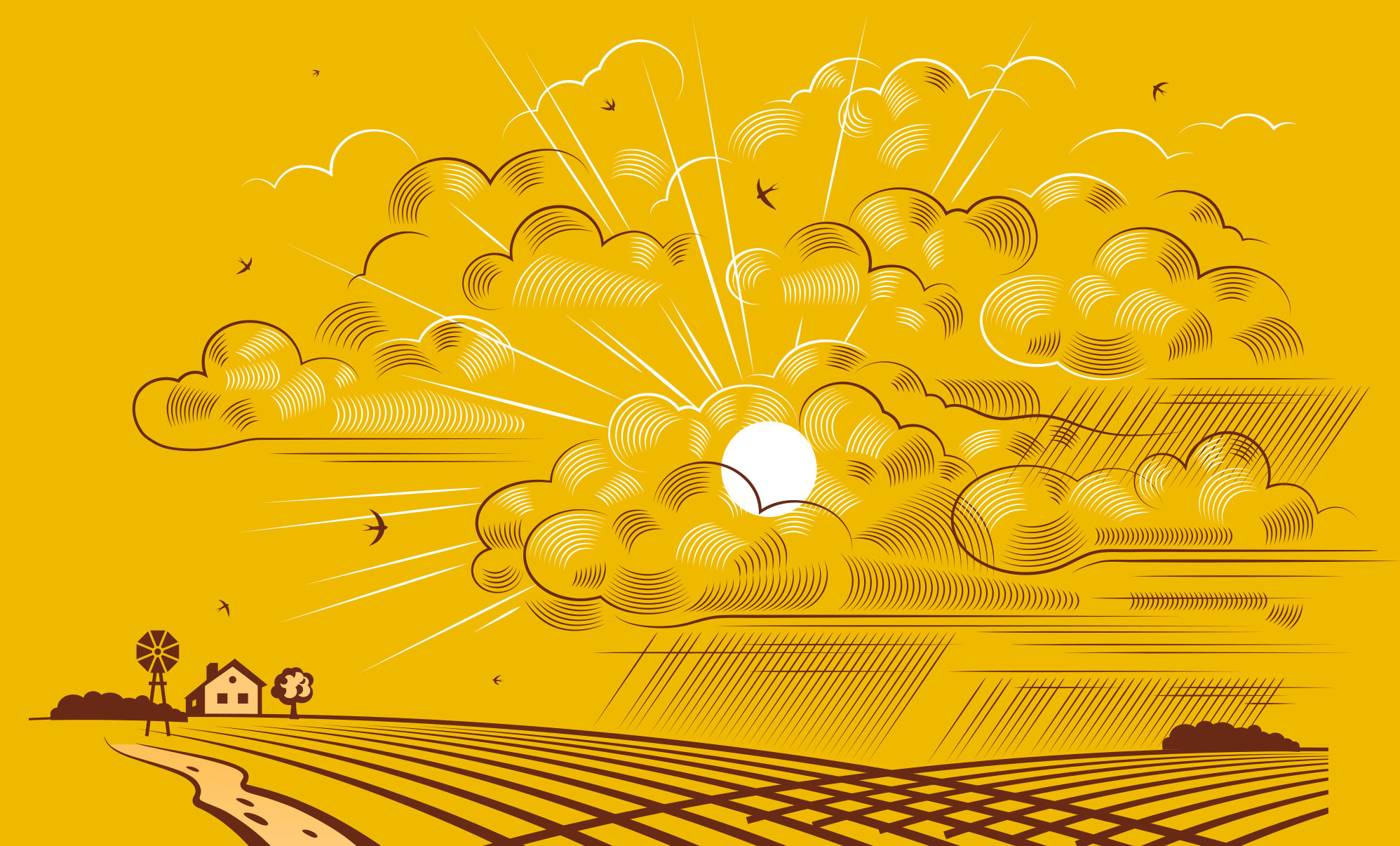The World and What We Eat
The complexities of climate change require an educated understanding of individual ingredients, their contribution, and how we can do better.

From a distance, as a blue-green orb in stark comparison to Mars’ red or Venus’ ashy-gray, Earth would appear to be just fine. But as we’ve learned—perhaps no more starkly than during this past year, zooming in reveals a different story. It’s the story of 7.8 billion people and the complicated question of how we feed them all.
In answering this question, we realize Earth is not fine. Her natural cycles are shifting, her land is dying, and her atmosphere is slowly heating. Climate change, the umbrella term often used to categorize all its ills, is very real. What’s more abstract and difficult to determine is how exactly to solve this problem.
When considering the food decisions that we make, it’s becoming increasingly clear that how we get our food is just as important as what we’re eating. In terms of environmental impact, for example, is it better to eat the beef from the local farm up the road? Or the plant-based burger with monocropped-grain, shipped cross-country on a diesel truck? There’s a cost behind every meal.
Greenhouse gases (GHGs), primarily CO2, methane and nitrous oxide, trap and reflect heat back toward Earth in the phenomenon known as the greenhouse effect. Worldwide, agriculture is responsible for 25% of all GHG emissions. In the United States, that figure is 10%. (The top global GHG emitter is energy production. In the U.S., it’s transportation.)
“We’ve built an economy that incentivizes taking carbon out of soils and putting it somewhere else, into the atmosphere,” explains Pelayo Alvarez, director of outreach and partnerships for the Carbon Cycle Institute (CCI). CCI helps farmers and ranchers—those who Alvarez refers to as “natural resource managers”—maximize their ability to sequester carbon through practices that generate healthy soil. Healthy soil, as defined by the USDA’s Natural Resources Conservation Service, functions as a vital living ecosystem that sustains plants, animals and humans.
Today, according to the United Nations’ Food and Agriculture Organization, the world’s soil health is so poor that only sixty viable harvests remain. That’s just thirty years’ worth left.
Though a driver of devastation, agriculture may just prove to be our tool for deliverance. Because of its reliance on and integration with the soil, agriculture is also the only human-managed sector that’s uniquely able to transform from a net emitter of CO2 (a carbon source) to a net sequester of CO2 (a carbon sink).
“It’s more about how we manage our soils than about what we’re growing,” Alvarez explains, saying he doesn’t feel hopeless about climate change because “there is a solution right in front of us, which is soil and the way we produce our food.”
“Complex systems require complex solutions,” Alvarez says, noting that despite being able to identify and measure different food sectors, we should be careful about drawing overly-simplified conclusions. When working together, consumers and producers can benefit from a diverse, resilient food system where the true cost of food is clearly communicated.
“As consumers, if you have climate-beneficial milks, beef and wool products that are produced in a way that allows agriculture to be a carbon sink, then you can make a decision,” he advises. “Good information is better than telling people what to do.”
To understand this more practically, let’s take a look at the ways a few of our most popular, and possibly controversial, crops currently affect the planet.

Avocados
Avocado popularity has skyrocketed in the U.S. since 2001, when consumption was primarily of Californian production and roughly two pounds per person. By 2018, per capita consumption of avocados had jumped to nearly eight pounds. A now year-round demand for the fruit has elevated Mexico to lead 33% of global avocado production and dominate 89% of U.S. avocado imports.
Like other commodity crops—coffee, soy, sugar, palm oil—avocados are most frequently grown as monocultures, meaning the land is used and reused for the same crop in the same space annually. While this carries a financial benefit for producers, it has disastrous consequences for soil which is depleted of vital nutrients, leaving it susceptible to pests and disease, and requires an increase in agrochemical (fertilizer and pesticide) use that leaches into surrounding waterways, speeding erosion and reducing land biodiversity.
Avocado production has also been linked to deforestation. Increasing crop production requires planting young trees beneath forest canopies that are then cut down to give the growing plants more access to light. A 2016 study in Michoacán, the Mexican state that produces over 75% of the country’s avocados (and whose forests are a winter sanctuary for the threatened monarch butterfly), found that 30% to 40% of its yearly deforestation was due to avocado orchards—orchards that also use twice as much water as the natural vegetation. It takes an average of 528 gallons of water to produce approximately 2.2 pounds of avocados. That’s roughly the amount in one party-size bowl of guacamole.
How we can do better: Policies that evaluate soil suitability and water scarcity, that ensure local communities have priority access to clean water, forests are protected, and interference from organized crime minimized. On the consumer level, balancing the avocado’s (environmental, cultural and long-term) costs with its demand. And planting a diverse range of crops to maximize soil health.

Almonds
Between 2010 and 2015, the almond milk market increased by 250%. In California, where 80% of the world’s almond supply is grown, water is the primary concern. One gallon of water is required to grow a single almond. California farmers grew 2.5 billion pounds of almonds in 2019, and critics have argued the nut’s water need is too high to justify. Rising demand has drained aquifers, increased drilling for new wells, and converted at least 16,000 acres of wetlands into almond orchards. Unlike row crops, which can be left fallow in different seasons, almond trees require year-round watering. This puts significant strain on a state that, as of November 2020, is already showing warning signs of entering another multi-year drought.
The use of pesticides and fungicides is another concern. A USDA Pesticide Data Program found the residue of nine different pesticides on commercially grown almonds, at least five of which are toxic to honeybees. Over 80% of the country’s honeybees are shipped to California every February, solely to be used during bloom to pollinate almond orchards. The use of insecticide-containing fungicides (also sprayed during bloom) has been linked to the disease and death of several honeybee colonies.
How we can do better: Choosing organic almond milk, which uses no pesticides and often less water. Rotating purchases of different alternative milks, including oat, sheep or goat’s milk. And making almond milk at home with organic almonds, which controls the amount of water used.

Grains
Three crops—corn, rice and wheat—provide nearly 60% of calories that humans consume. In 2016, nearly half of all cultivated land (more than 1.7 billion acres) was dedicated to growing these grains worldwide. As annual monocrops, planting is required every year, leading to the high use of pesticides and fertilizers to prevent any competition with the growing, profitable plant. This has led to a jump by as much as 600%, in some cases, in reactive nitrogen levels in the environment.
Soil bacteria convert fertilizer nitrogen into nitrates, which then get carried into groundwater and river systems by rain. When it’s been overly tilled and exhausted of nutrients, monocropped soil turns into dirt that doesn’t absorb and is susceptible to erosion and water runoff. The resulting accumulation of nitrogen and phosphorus in aquatic systems leads to eutrophication (a form of nutrient pollution), which has been linked to toxic algae blooms, oxygen depletion, and a loss of both land and water biodiversity.
Nitrous oxide (N2O)—the greenhouse gas that’s three hundred times more warming than CO2—is also generated through fertilizer application. It’s estimated that human emissions of N2O have increased by 30% since 1980, with almost 80% of that due to agriculture’s use of synthetic fertilizer. (Another 5% of N2O emissions is due to manure management.)
How we can do better: Policies that limit N2O emissions, timing fertilizer application to avoid rain, using no-till technology, and using micro-irrigation to reduce flooding, which is associated with higher N2O emissions. Replenishing soil naturally through compost application, organic matter, and regenerative, carbon-sequestering practices. And the development of cereal crops that work like legumes to fix their own nitrogen, reducing the need for fertilizer.

Beef
The true implications of raising and eating beef are harder to measure than one might expect. Cattle’s many data points—GHG emissions, land use, crop use, nutrient density—each reflect a trade-off with varied environmental costs. A cow’s unique lifecycle highlights the complexity of the climate change equation.
When compared to other agricultural sectors, beef oscillates between being a net sink and a net source of carbon. On average, a cow will spend two thirds of its life on pasture (sink) and the final third on a feedlot (source), the confined space designed to minimize energy expenditure and streamline a fattened “finishing” weight. Feedlots generate large concentrations of urine and manure, resulting in emissions of N2O, ammonia and methane. Poorly managed feedlots create an increase in antibiotic use and soil erosion, and generate acrid winds of fecal dust.
Cattle is responsible for almost 65% of the livestock’s sector of GHG emissions (livestock, as a whole, is responsible for 14% of all GHGs from human activity), and methane gets a lot of this attention. Though less concentrated in the atmosphere than CO2, methane is thirty times more effective at trapping heat. It’s also cycled out of the atmosphere ten times faster; methane stays in the atmosphere for roughly a decade, while CO2 stays in the atmosphere for centuries.
Deforestation is also a concern. In the Amazon Basin of Brazil, the world’s leading producer and exporter of cattle, the demand for beef has increased 10% year after year. Brazilian rainforests have been routinely burned for decades to clear space for cattle grazing, whether funded through meatpacking giants or small farmers hoping to carve out a more livable income. On average, one pound of beef requires 298 square feet of land and 211 gallons of water. One cow can produce up to four hundred pounds of beef.
And yet, with over half of its life spent on rangeland, cattle also provide a rare solution: soil regeneration. Trees and vegetation, which also sequester carbon, burn in wildfires. Healthy soil can be a permanent carbon sink, with an ability to draw and store more carbon in its first three feet around the world than the amount of carbon currently in the atmosphere. As overgrazing and monocropping degrade soil’s vitality, well-managed cattle herds have been shown to do the opposite. When cows move and graze rotationally, they leave just enough vegetation behind for the soil to trap and filter water, grow grasses back more quickly, and host a diverse network of soil microbes to keep carbon out of the atmosphere and in the ground.
How we can do better: Environmental policies that protect forests, waterways and ecosystems. Economic policies that provide income-generating alternatives for cattle ranchers, particularly in Brazil and other developing countries. Supporting sustainable ranchers who utilize rotational grazing and other practices that regenerate the soil. And considering how much meat is essential, its source, and its environmental cost.






Our comments section is for members only.
Join today to gain exclusive access.